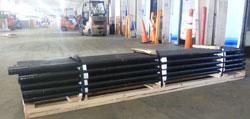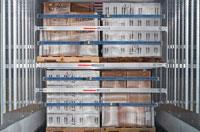Senior Vice President, Operations
- FMA
- The Fabricator
- FABTECH
- Canadian Metalworking
Categories
- Additive Manufacturing
- Aluminum Welding
- Arc Welding
- Assembly and Joining
- Automation and Robotics
- Bending and Forming
- Consumables
- Cutting and Weld Prep
- Electric Vehicles
- En Español
- Finishing
- Hydroforming
- Laser Cutting
- Laser Welding
- Machining
- Manufacturing Software
- Materials Handling
- Metals/Materials
- Oxyfuel Cutting
- Plasma Cutting
- Power Tools
- Punching and Other Holemaking
- Roll Forming
- Safety
- Sawing
- Shearing
- Shop Management
- Testing and Measuring
- Tube and Pipe Fabrication
- Tube and Pipe Production
- Waterjet Cutting
Industry Directory
Webcasts
Podcasts
FAB 40
Advertise
Subscribe
Account Login
Search
Staying safe shipping metal products
Lighter-than-truckload shipments require additional care
- By Tom Clark
- August 3, 2012
- Article
- Shop Management

Figure 1: This shrink-wrapped package is probably more about protecting the surface finish of the parts than it is about protecting workers as they move the pallet. When moving such a package in a less-than-truckload scenario, shippers must be sure to secure the metal parts to prevent possible movement, which could damage the parts and potentially endanger workers entering the trailer to unload them.
At a time when customers want their metal part orders yesterday, metal fabricators are used to sending out less-than-truckload (LTL) deliveries on a regular basis. This type of LTL freight comes in all shapes and sizes—some of which can be more cumbersome and problematic to ship than others.
As a result, these fabricated metal parts can present some significant challenges for those that deliver their own parts or those that use a traditional LTL service, which for many is a cost-effective and reliable option for time-sensitive shipments. Chief among those challenges is safety.
In a perfect world, standard freight would comprise a 40- by 48-in. pallet, neatly and squarely packaged for efficient movement on and off a truck. Unfortunately, the dimensions of highly engineered metal products don’t often allow for this type of perfect-world scenario. These products come in multiple shapes, from metal cylinders and coils to sheet metal and other flat stock, and can often run the length of a 28-foot trailer. Metal products of awkward shape, length, and dimension are often very heavy as well, and they require individual consideration and attention to ensure the integrity of the product and the safety of those involved in the shipping process.
Safety Considerations
Packaging is the prime concern when it comes to shipping metal products in LTL situations. Shrink-wrapping a pallet or placing the freight into a crate isn’t always possible because of the products’ unique size, shape, or weight. Metal rods, for instance, can be especially difficult to ship. For example, six 20-ft.-long, 2-in.-diameter metal cylinders banded together—weighing in at 1,000 pounds—can be described as a “package,” but in reality those bands can snap easily when the cylinders are being loaded or unloaded. They often break loose because the bands can’t handle the stress of being loaded and unloaded multiple times.
This can happen even if the metal cylinders are crated. In that case, the integrity of the crate is often compromised after multiple material handling stages. Poorly packaged material can injure those directly handling it, as well as others on the dock.
Shipping fabricated or manufactured metal products has some inherent challenges that require special attention and diligence to ensure safe handling and worry-free delivery. With the right planning, carriers and shippers can reduce and hopefully prevent the risk of injury.
Learn and Enforce the Rules. To achieve the highest levels of efficiency on the road and on the dock, all parties involved in the shipping process need to be aligned and working from the same playbook. The National Motor Freight Classification (NMFC) standards provide valuable insight and information on how to move freight safely and securely. The NMFC guide gives commodity descriptions, transportation rules, and packaging requirements.
For example, sheet steel falls under item No. 106740 per the NMFC. This item number contains all of the information the shipper needs to know about packaging and, in this case, is required to crate it. By doing so, the shipper protects the product during transit and reduces the risk of injury to dockworkers and drivers. Knowing the freight’s class, weight, and type of product, carriers can best determine how to package and move it around the dock and into the truck. The NMFC standards act as a checks and balances system that, when followed, helps to ensure the safety of both parties. Full details about the NMFC standards can be found on the National Motor Freight Traffic Association’s website, www.nmfta.org.
Get Innovative to Secure Freight. From nailing 2-by-4s alongside freight that lines a trailer floor to utilizing straps to hold freight in place, a fabricator needs to apply innovative thinking when it comes to shipping metal products safely. Some LTL carriers actually have moved beyond their “inner MacGyvers” and related quick-fix schemes and have installed advanced load management and cargo protection systems in their trucks and trailers. When appropriate, these systems can make a big difference in reducing handling and the chance of injury and product damage.
What makes up such advanced loading and protection setups? These adjustable decking and securing systems have heavy-duty aluminum tracks that are attached to supporting vertical posts along the trailer walls. Height-adjustable, horizontal shoring beams then clamp securely into the vertical tracks and can be moved up and down in 1-in. increments, creating multiple decking platforms set at precise levels for palletized freight of various shapes and sizes. Such systems often have custom-designed anchors and heavy-duty straps that securely brace and tie down shipments to prevent movement in transit.

Figure 2: Steel bands may look secure, but they can snap if loading or unloading is not smooth. To stay safe, shipping personnel always need to be aware when metal parts are being moved.
Take Precautions. Effective safety plans, training, proper equipment, and education are the foundation of a safe working environment. When it comes to shipping metal products, company managers should ensure employees have the training and the right equipment—personal protective gear like gloves and coverings for work boots, and straps and booms to help move product safely and efficiently—to handle and transport metal products properly.
Use the Tools Available. Common sense, teamwork, and planning are essential to keeping safety top of mind, whether it’s at the fabricator’s loading dock or the LTL carrier’s cross-dock. The packaging—or lack thereof—of metal products should be assessed before any action is taken. Booms, reinforced straps, and forklifts to move metal products safely and efficiently around the dock are available to help.
Using forklifts to transport long, off-balance materials comes with its own hazards. Following strict operating procedure is paramount to ensure the forklift operator’s safety, as well as those along the dock.
LTL shipping of metal products can be done safely and effectively, but only if shippers and carriers communicate and collaborate effectively to apply the right tools, techniques, and, most of all, secure, effective packaging to ensure a successful experience.
About the Author
Tom Clark
2211 Old Earhart Road, Suite 100
Ann Arbor, MI 48105
734-994-6600
subscribe now

The Fabricator is North America's leading magazine for the metal forming and fabricating industry. The magazine delivers the news, technical articles, and case histories that enable fabricators to do their jobs more efficiently. The Fabricator has served the industry since 1970.
start your free subscription- Stay connected from anywhere

Easily access valuable industry resources now with full access to the digital edition of The Fabricator.

Easily access valuable industry resources now with full access to the digital edition of The Welder.

Easily access valuable industry resources now with full access to the digital edition of The Tube and Pipe Journal.
- Podcasting
- Podcast:
- The Fabricator Podcast
- Published:
- 04/16/2024
- Running Time:
- 63:29
In this episode of The Fabricator Podcast, Caleb Chamberlain, co-founder and CEO of OSH Cut, discusses his company’s...
- Trending Articles
How to set a press brake backgauge manually

Capturing, recording equipment inspection data for FMEA

Tips for creating sheet metal tubes with perforations

Are two heads better than one in fiber laser cutting?

Hypertherm Associates implements Rapyuta Robotics AMRs in warehouse

- Industry Events
16th Annual Safety Conference
- April 30 - May 1, 2024
- Elgin,
Pipe and Tube Conference
- May 21 - 22, 2024
- Omaha, NE
World-Class Roll Forming Workshop
- June 5 - 6, 2024
- Louisville, KY
Advanced Laser Application Workshop
- June 25 - 27, 2024
- Novi, MI



























